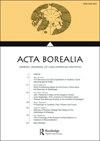Second world war as a trigger for transcultural changes among Sámi people in Finland
IF 0.6
4区 社会学
0 HUMANITIES, MULTIDISCIPLINARY
引用次数: 18
Abstract
ABSTRACT The article analyses the consequences of the Lapland War (1944–45) and the reconstruction period (1945–52) for the Sámi society in Finnish Lapland, and provides some comparisons to the situation in Norway. Reconstructing the devastated Lapland meant powerful and rapid changes that ranged from novelties of material culture to increasing Finnish ideals, from a transition in the way of life to an assimilation process. The war was a trigger to an accelerated development in which otherwise long-term processes happened in a very short time frame in the post-war period. The post-war development was characterized by economic, political and cultural processes that integrated Sámiland to Finland and the Finnish nation. These processes can be interpreted as a classic modernization process, even “finnicization”, in which the traditional Sámi culture was forced to switch over to the modern large-scale society. In addition to problematic changes, however, the consequences of the war are also considered to have created new possibilities for the Sámi to influence the majority society both as individuals and as ethno-political actors. This was reflected in Sámi ethnopolitical activism, which started in Finland only after WWII. Also, the role of the majority education system had two-fold consequences: strong assimilation features, but also helping to build the educated Sámi “radical” generation that challenged the prevalent Sámi politics in the 1960s.第二次世界大战引发了Sámi芬兰人的跨文化变化
本文分析了拉普兰战争(1944 - 1945)和重建时期(1945 - 1952)对芬兰拉普兰Sámi社会的影响,并与挪威的情况进行了比较。重建被摧毁的拉普兰意味着强大而迅速的变化,从物质文化的新奇到芬兰理想的增加,从生活方式的转变到同化过程。这场战争是加速发展的导火索,否则长期的进程就会在战后很短的时间内发生。战后发展的特点是经济、政治和文化进程使Sámiland与芬兰和芬兰民族融为一体。这些过程可以理解为一个经典的现代化过程,甚至是“finnicization”,在这个过程中,传统的Sámi文化被迫向现代大规模社会过渡。然而,除了有问题的变化之外,战争的后果也被认为为Sámi作为个人和作为民族政治行为者影响多数社会创造了新的可能性。这反映在Sámi民族政治行动主义中,它是二战后才在芬兰开始的。此外,多数教育系统的作用具有双重后果:强烈的同化特征,但也有助于建立受过教育的Sámi“激进”一代,挑战20世纪60年代流行的Sámi政治。
本文章由计算机程序翻译,如有差异,请以英文原文为准。
求助全文
约1分钟内获得全文
求助全文

 求助内容:
求助内容: 应助结果提醒方式:
应助结果提醒方式:


